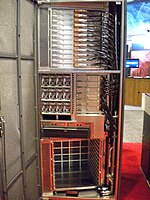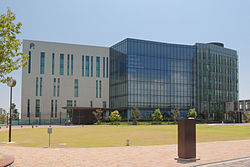K computer
 | |
| Active | Operational June 2011 |
|---|---|
| Sponsors | MEXT, |
| Operators | Fujitsu |
| Location | RIKEN Advanced Institute for Computational Science |
| Architecture | 88,128 SPARC64 VIIIfx processors, Tofu interconnect |
| Power | 12.6 MW |
| Operating system | Linux[1][2] |
| Speed | 10.51 petaflops (Rmax) |
| Ranking | TOP500: 5th, as of August 2016[update][3] |

The K computer – named for the Japanese word "kei" (京), meaning 10 quadrillion (1016)[4][Note 1] – is a supercomputer manufactured by Fujitsu, currently installed at the RIKEN Advanced Institute for Computational Science campus in Kobe, Japan.[4][5][6] The K computer is based on a distributed memory architecture with over 80,000 computer nodes.[7] It is used for a variety of applications, including climate research, disaster prevention and medical research.[6] The K computer's operating system is based on the Linux kernel, with additional drivers designed to make use of the computer's hardware.[8]
In June 2011, TOP500 ranked K the world's fastest supercomputer, with a computation speed of over 8 petaflops, and in November 2011, K became the first computer to top 10 petaflops.[9][10] It had originally been slated for completion in June 2012.[10] In June 2012, K was superseded as the world's fastest supercomputer by the American IBM Sequoia;[11] and as of August 2016,[3] K is the world's fifth-fastest computer.
Performance
On 20 June 2011, the TOP500 Project Committee announced that K had set a LINPACK record with a performance of 8.162 petaflops, making it the fastest supercomputer in the world at the time;[4][6][9] it achieved this performance with a computing efficiency ratio of 93.0%. The previous record holder was the Chinese National University of Defense Technology's Tianhe-1A, which performed at 2.507 petaflops.[5] The TOP500 list is revised semiannually, and the rankings change frequently, indicating the speed at which computing power is increasing.[4] In November 2011, RIKEN reported that K had become the first supercomputer to exceed 10 petaflops, achieving a LINPACK performance of 10.51 quadrillion computations per second with a computing efficiency ratio of 93.2%.[10] K received top ranking in all four performance benchmarks at the 2011 HPC Challenge Awards.[12]
On 18 June 2012, the TOP500 Project Committee announced that the California-based IBM Sequoia supercomputer had replaced K as the world's fastest supercomputer, with a LINPACK performance of 16.325 petaflops. Sequoia is 55% faster than K, utilising 123% more CPU processors, but is also 150% more energy efficient.[11] As of June 2013, the world's fastest supercomputer is China's Tianhe-2, capable of a LINPACK performance of over 33 petaflops;[13]
On the TOP500 list, it became the third since November 2012, fourth since June 2013, fifth since June 2016.[14]
K computer holds second place in the HPCG benchmark test proposed by Jack Dongarra, with 0.427 HPCG PFLOPS in June 2014.[15]
Specifications
Node architecture
The K computer comprises 88,128 2.0 GHz eight-core SPARC64 VIIIfx processors contained in 864 cabinets, for a total of 705,024 cores,[1][16] manufactured by Fujitsu with 45 nm CMOS technology.[17] Each cabinet contains 96 computing nodes, in addition to 6 I/O nodes. Each computing node contains a single processor and 16 GB of memory. The computer's water cooling system is designed to minimize failure rate and power consumption.[18]
Network
The nodes are interconnected by Fujitsu's proprietary Torus fusion (Tofu) interconnect. Tofu has a six-dimensional mesh/torus topology, a scalability of over 100,000 nodes, and full-duplex links that have a peak bandwidth of 10 GB/s (5 GB/s per direction). Each node is connected to its own InterConnect Controller (ICC) chip, which contains four Tofu interfaces (one for the node and three for connecting to other ICC chips) and a router. Tofu's six-dimensional mesh/torus topology is abstracted by software to appear as a three-dimensional torus; and is supported by a Tofu-optimized version of the open-source Open MPI Message Passing Interface library.[18][19][20] Users can create application programs adapted to either a one-, two-, or three-dimensional torus network.[21]
File system
The system adopts a two-level local/global file system with parallel/distributed functions, and provides users with an automatic staging function for moving files between global and local file systems. Fujitsu developed an optimized parallel file system based on Lustre, called the Fujitsu Exabyte File System (FEFS), which is scalable to several hundred petabytes.[18][22]
Power consumption
Although the K computer reported the highest total power consumption of any 2011 TOP500 supercomputer (9.89 MW – the equivalent of almost 10,000 suburban homes), it is relatively efficient, achieving 824.6 GFlop/kWatt. This is 29.8% more efficient than China's NUDT TH MPP (ranked #2 in 2011), and 225.8% more efficient than Oak Ridge's Jaguar-Cray XT5-HE (ranked #3 in 2011). However, K's power efficiency still falls far short of the 2097.2 GFlops/kWatt supercomputer record set by IBM's NNSA/SC Blue Gene/Q Prototype 2. For comparison, the average power consumption of a TOP 10 system in 2011 was 4.3 MW, and the average efficiency was 463.7 GFlop/kW.[9]
According to TOP500 compiler Jack Dongarra, professor of electrical engineering and computer science at the University of Tennessee, the K computer's performance equals "one million linked desktop computers".[5] The computer's annual running costs are estimated at US$10 million.[5]
K Computer Mae rapid transit station
On 1 July 2011, Kobe's Port Island Line rapid transit system renamed one of its stations "K Computer Mae" (meaning "In front of K Computer") in honour of the supercomputer.[23]
See also
Notes
- ^ See Japanese numbers
References
- ^ a b K computer, SPARC64 VIIIfs 2.0GHz, Tofu interconnect
- ^ Moroo, Jun; et al. (2012). "Operation System for the K computer" (PDF). Fujitsu Sci. Tech. J. 48 (3): 295–301.
- ^ a b June 2016 TOP500 Supercomputer Sites
- ^ a b c d "Japanese 'K' Computer Is Ranked Most Powerful". The New York Times. 20 June 2011. Retrieved 20 June 2011.
- ^ a b c d "Japanese supercomputer 'K' is world's fastest". The Telegraph. 20 June 2011. Retrieved 20 June 2011.
- ^ a b c "Supercomputer "K computer" Takes First Place in World". Fujitsu. Retrieved 20 June 2011.
- ^ "The K computer: Japanese next-generation supercomputer development project". IEEE Xplore. 2011. Retrieved 30 January 2013.
- ^ Moroo et al. (2012) Operating System for the K computer. Fujitsu. Retrieved 18 June 2013.
- ^ a b c June 2011 TOP500 Supercomputer Sites
- ^ a b c "K computer" Achieves Goal of 10 Petaflops". Fujitsu. 2 November 2011. Retrieved 10 November. 2011.
- ^ a b "IBM supercomputer overtakes Fujitsu as world's fastest". BBC. 18 June 2012.
- ^ ""K computer" No. 1 in Four Benchmarks at HPC Challenge Awards". RIKEN. 17 November 2011. Retrieved 17 November 2011.
- ^ "China retakes supercomputer crown". BBC. 17 June 2013. Retrieved 18 June 2013.
- ^ "TOP500 Supercomputer Sites". Retrieved 22 June 2016.
- ^ Hemsoth, Nicole (26 June 2014). "New HPC Benchmark Delivers Promising Results". HPCWire. Retrieved 8 September 2014.
- ^ ""SPARC64™ VIIIfx": A Fast, Reliable, Low-power CPU". Fujitsu Global. Retrieved 24 February 2013.
- ^ Takumi Maruyama (2009). SPARC64(TM) VIIIfx: Fujitsu's New Generation Octo Core Processor for PETA Scale computing (PDF). Proceedings of Hot Chips 21. IEEE Computer Society. Retrieved 24 February 2013.
- ^ a b c "RIKEN Advanced Institute for Computational Science" (PDF). RIKEN. Retrieved 20 June 2011.
- ^ "Programming on K computer" (PDF). Fujitsu. Retrieved 24 June 2011.
- ^ "Open MPI powers 8 petaflops". Cisco Systems. Retrieved 24 June 2011.
- ^ Yuichiro Ajima; et al. (2009). "Tofu: A 6D Mesh/Torus Interconnect for Exascale Computers". Computer. 42 (11). IEEE Computer Society: 36–40. doi:10.1109/MC.2009.370.
- ^ "An Overview of Fujitsu's Lustre Based File System" (PDF). Fujitsu. Retrieved 24 June 2011.
- ^ "Japan's K Supercomputer". Trends in Japan. January 2012. Retrieved 6 June 2012.
External links
- RIKEN Advanced Institute for Computational Science
- RIKEN Next-Generation Supercomputer R&D Center
- K computer: Fujitsu Global
- Fujitsu Scientific & Technical Journal, July 2012 (Vol. 48, No. 3, The K computer
- Special Interview: Taking on the Challenge of a 10-Petaflop Computer, RIKEN News, No. 298, April 2006.
- June 2014 Graph 500

